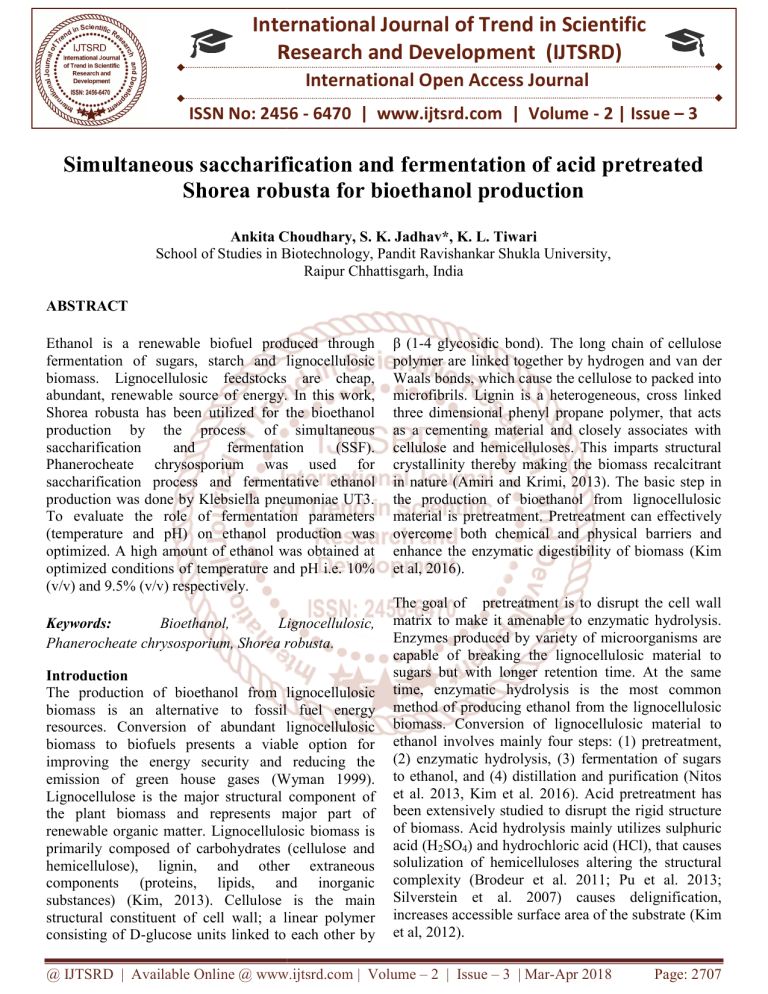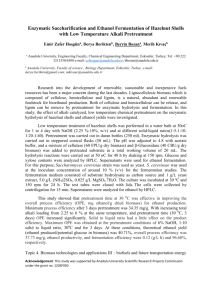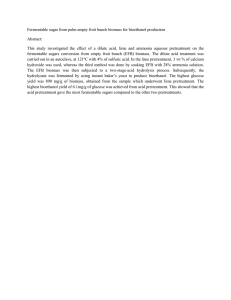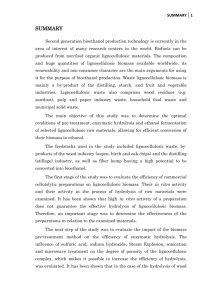
International Journal of Trend in Scientific
Research and Development (IJTSRD)
International Open Access Journal
ISSN No: 2456 - 6470 | www.ijtsrd.com | Volume - 2 | Issue – 3
Simultaneous saccharification and fermentation of acid pretreated
Shorea robusta for bioethanol production
Ankita Choudhary, S. K. Jadhav*, K. L. Tiwari
School of Studies
tudies in Biotechnology, Pandit Ravishankar Shukla University,
Raipur Chhattisgarh, India
ABSTRACT
Ethanol is a renewable biofuel produced through
fermentation of sugars, starch and lignocellulosic
biomass. Lignocellulosic feedstocks are cheap,
abundant, renewable
le source of energy. In this work,
Shorea robusta has been utilized for the bioethanol
production by the process of simultaneous
saccharification
and
fermentation
(SSF).
Phanerocheate chrysosporium was used for
saccharification process and fermentative eth
ethanol
production was done by Klebsiella pneumoniae UT3.
To evaluate the role of fermentation parameters
(temperature and pH) on ethanol production was
optimized. A high amount of ethanol was obtained at
optimized conditions of temperature and pH i.e. 10%
(v/v) and 9.5% (v/v) respectively.
Keywords:
Bioethanol,
Lignocellulosic,
Phanerocheate chrysosporium, Shorea robusta
robusta.
Introduction
The production of bioethanol from
m lignocellulosic
biomass is an alternative to fossil fuel eenergy
resources. Conversion of abundant lignocellulosic
biomass to biofuels presents a viable option for
improving the energy security and reducing the
emission of green house gases (Wyman 1999)
1999).
Lignocellulose is the major structural component of
the plant biomass and represents major part of
renewable organic matter. Lignocellulosic biomass is
primarily composed of carbohydrates (cellulose and
hemicellulose), lignin, and other extraneous
components
nts (proteins, lipids, and inorganic
substances) (Kim, 2013). Cellulose is the main
structural constituent of cell wall;; a linear polymer
consisting of D-glucose units linked
ked to each other by
β (1-4 glycosidic bond). The long chain of cellulose
polymer are linked together by
b hydrogen and van der
Waals bonds, which cause the cellulose to packed into
microfibrils. Lignin is a heterogeneous, cross linked
three dimensional phenyl propane polymer, that acts
as a cementing material and closely associates with
cellulose and hemicelluloses. This imparts structural
crystallinity thereby making the biomass recalcitrant
in nature (Amiri and
d Krimi, 2013).
2013) The basic step in
the production of bioethanol from lignocellulosic
material is pretreatment. Pretreatment can effectively
overcome both chemical and physical barriers and
enhance the enzymatic digestibility of biomass (Kim
et al, 2016).
The goal of pretreatment is to disrupt the cell wall
matrix to make it amenable to enzymatic hydrolysis.
hydrolysis
Enzymes produced by variety of microorganisms are
capable of breaking
reaking the lignocellulosic material to
sugars but with longer retention time. At the same
time, enzymatic hydrolysis is the most common
method of producing ethanol from the lignocellulosic
biomass. Conversion of lignocellulosic material to
ethanol involves mainly four steps: (1) pretreatment,
(2) enzymatic hydrolysis, (3) fermentation of sugars
to ethanol, and (4) distillation and purification (Nitos
et al. 2013, Kim et al. 2016).
). Acid pretreatment has
been extensively studied to disrupt the rigid structure
struc
of biomass. Acid hydrolysis mainly utilizes
u
sulphuric
acid (H2SO4) and
d hydrochloric acid (HCl), that causes
solulization of hemicelluloses altering the structural
complexity (Brodeur et al. 2011; Pu et al. 2013;
Silverstein et al. 2007) causes delignification,
increases accessible surface area of the substrate (Kim
et al, 2012).
@ IJTSRD | Available Online @ www.ijtsrd.com | Volume – 2 | Issue – 3 | Mar-Apr
Apr 2018
Page: 2707
International Journal of Trend in Scientific Research and Development (IJTSRD) ISSN: 2456-6470
Materials and methods
Sample collection: Shorea robusta (Sal) seeds were
collected from Village Sargipal, Bakawand range,
Jagdalpur forest region, Chhattisgarh India.
Physical pretreatment: Sample was grinded for size
reduction to 0.2 mm size and was further dried in
oven at 40°C for 2 hours.
Chemical (acid) pretreatment: 1.5 % (v/v) of
hydrochloric acid was added to physically pretreated
Shorea robusta substrates. The sample was left for 24
hours at room temperature. The mixture was filtered
washed to neutrality with distilled water, oven dried at
40 0C to a constant weight and then milled to powder,
further used for fermentation.
Simultaneous saccharification and fermentation:
The
chemically
treated
biomass
was
added with Phanerocheate chrysosporium followed
by Klebsiella pneumoniae UT3. After the
saccharification process, reducing sugar estimated by
DNS (Dinitro-Salicylate) method (Miller, 1989).
Optimization of parameters: To evaluate the effects
on fermentation process the physical parameter
temperature and pH was optimized. The SSF was
carried at temperature 25 0C, 30 0C, 35 0C, 40 0C. A
similar study was performed with different pH of 5, 6,
7.
Fractional distillation and estimation: The
fermented samples were transferred into round bottom
flask fixed to a distillation column with running tap
water for cooling. A conical flask was fixed to a
distillation column at the other end to collect the
distillate (Maurya et. al, 2015; Nzelibe and Okafoagu,
2007; Oyeleke and Jibrin, 2009). The ethanol content
was measured using specific gravity method
(Pharmacopoeia of India, 1985). The percent of
ethanol was calculated using following formula:
ρt0 = W3- W1× Density of water at t0
W2-W1
where ρt0 = specific gravity, W1 = weight of empty
specific gravity bottle, W2 = weight of empty bottle +
distilled water, W3 = weight of empty bottle +
fermented liquid (Yadav, 2003).
Results: The physical parameters affecting like
temperature and pH have been optimized and increase
in the yield of ethanol was recorded. At optimum
conditions of temperature the maximum of 10.0%
(v/v) ethanol was achieved at 35 0C and 9.5% (v/v) at
pH 6.
Discussions: The digestibility of lignocelluloses is
hindered by many structural and compositional factors
which require an effective pretreatment to enhance the
susceptibility of biomass for hydrolysis and
fermentation. It is necessary for the production of
ethanol that both the cellulose and hemicellulose
should be converted to fermentable sugars that could
be efficiently utilized by the microorganisms for the
production of ethanol. The main objective of the acid
pretreatment is chemical hydrolysis that causes
solubilization of hemicelluloses and lignin making the
cellulose more accessible to enzymes (Maurya, 2015).
Physical pretreatment and dilute acid pretreatmet was
the employed for hydrolysis of the substrate. The
pretreatment process can remove hemicellulose,
reduce cellulose crystallinity, and increase the
porosity of the materials. Enzymatic saccharification
of chemically treated substrate using Phanerocheate
chrysosporium effectively reduces the lignin content
and crystallinity of lignocellulosic biomass that
usually prevents penetration of cellulase in the
lignocellulose that results in low enzymatic activity
(Yang et al. 2010). The slow rate of hydrolysis results
due to the slow action of enzymes, because of
obstacles that interfere with their path or a loss in
activity or processivity making them less effective
(Yang et al. 2006). During SSF process, enzymatic
hydrolysis and fermentation takes place in the same
vessel. The simple sugars released during
saccharification by Phanerocheate chrysosporium is
simultaneously consumed and fermented by
Klebsiella
pneumoniae
UT3.
The
higher
saccharification results in better utilization of
fermentable sugars after fungal pretreatment towards
fermentation. To better understand the differences
among the effects were grouped according to the
results of statistical analysis. Temperature plays a
significant role in the functional activity and stability
of enzymes.
All cellular reactions occur at
measurable rates due to the presence of enzymes. At
optimum temperatures the kinetic energy of molecules
increases thereby overcoming the barriers to finally
firm the products. The overall results of the work
showed that Phanerocheate chrysosporium effectively
digests the cellulose and lignin content present in the
biomass. Maximum cellulose and lignin degradation
occurs at optimum temperature and pH. The results
@ IJTSRD | Available Online @ www.ijtsrd.com | Volume – 2 | Issue – 3 | Mar-Apr 2018
Page: 2708
International Journal of Trend in Scientific Research and Development (IJTSRD) ISSN: 2456-6470
indicate that bioethanol can be produced from Shorea
robusta by the
process
of simultaneous
saccharification and fermentation.
Table no. 1. Optimization of temperature for
bioethanol
production
by
simultaneous
saccharification and fermentation
Sl.
Temperature Ethanol percentage (v/v)
No.
(0C)
1
25
5.4 ± .2d
2
30
6.4 ±.1c
3
35
10.0 ±.0a
4
40
7.1 ± .2b
Each step was repeated 3 times. All the values are
mean ± standard error, values differ significantly at
5% as analyzed by Duncan multiple Range Test by
SPSS
Table no. 2. Optimization of pH for bioethanol
production by simultaneous saccharification and
fermentation.
Sl.
No.
1
2
3
pH
Ethanol percentage (v/v)
5
6
7
6.6 ± .3c
9.5 ± .0a
8.2 ± .0 b
Each step was repeated 3 times. All the values are
mean ± standard error, values differ significantly at
5% as analyzed by Duncan multiple Range Test by
SPSS
12
10
8
Ethanol
6
%
(v/v/) 4
10
9
8
7
Ethanol % 6
5
(v/v/)
4
3
2
1
0
5
6
7
pH
Fig 2. Optimization of pH for bioethanol production
by simultaneous saccharification and fermentation
Conclusions
Utilization of renewable substrate for the production
of bioethanol is the viable and best alternative to the
fossil fuels. For fulfilling the world’s energy demand,
exploring more renewable sources has opened new
doors for conserving the environment. Use of
lignocellulosic biomass for ethanol production
mitigates the release of green house gases especially
carbon- di-oxide in the environment. Thus, it
contributes to green and clean energy for the
sustainable development of the society.
Acknowledgement: Author is grateful to Head,
School of Studies in Biotechnology, Pt. Ravishankar
Shukla University Raipur, Chhattisgarh, India for
providing research facilities and valuable guidance for
research work. I acknowledge DST INSPIRE, New
Delhi
(No.
DST/INSPIRE
Fellowship/2015/IF150194) for providing me
financial support for my research work.
References:
2
0
25
30
35
Temperature
40
0C
Fig 1. Optimization of temperature for bioethanol
production by simultaneous saccharification and
fermentation.
1) Amiri, H. Karimi, K. 2013, Efficient Dilute-Acid
Hydrolysis of Cellulose Using Solvent
Pretreatment, Industrial & Engineering Chemistry
Research, 52: 11494-11501.
2) Brodeur, G., Yau, E., Badal, K., Collier, J.,
Ramachandran, K. B., & Ramakrishnan, S. 2011.
Chemical and physicochemical pretreatment of
lignocellulosic biomass: A review. Enzyme
Research,
http://dx.doi.org/10.4061/2011/787532Chen
@ IJTSRD | Available Online @ www.ijtsrd.com | Volume – 2 | Issue – 3 | Mar-Apr 2018
Page: 2709
International Journal of Trend in Scientific Research and Development (IJTSRD) ISSN: 2456-6470
3) Kim, B. Gulati, I. Park, J. Shin, J. S. 2012.
Pretreatment of cellulosic waste sawdust into
reducing sugars using mercerization and
etherification. Bioresources, 7(4): 5152-5166.
cellulose with conversion. Biotechnol. Bioeng,
94(6): 1122-1128.
4) Kim, J. S. Lee, Y.Y. and Kim T. H. 2016. A
review on alkaline pretreatment technology for
bioconversion of lignocellulosic biomass.
Bioresource Technology, 199: 42–48.
5) Maurya, D. P., Singla, A. and Negi, S. 2015. An
overview of key pretreatment processes for
biological conversion of lignocellulosic biomass
to bioethanol. 3 Biotech, 5: 597–609.
6) Nitsos, C. K., Matis, K. A., & Triantafyllidis, K.
S.
(2013).
Optimization
of
hydrothermalpretreatment
of
lignocellulosic
biomass
in
the
bioethanol
production
process.Chem Sus Chem, 6(1): 110–122.
7) Nzelibe, H.C.N. Okafoagu, U.C. 2007.
Optimization of ethanol production from garcinia
kola (bitter kola) pulp Agro Waste, African
Journal of Biotechnology, 6(17): 2033-2037.
8) Oyeleke, S.B. Jibrin, N.M. 2009. Production of
ethanol from guinea cornhusk and millet husk.
African Journal of Microbiology Research, 3(4):
147 – 152.
9) Pharmacopoeia of India (1985) The Indian
pharmacopoeia. Published by the Controller of
publications. 3rd edn, vol 2, pp 113–115.
10) Pu, Y., Hu, F., Huang, F., Davison, B., &
Ragauskas,
A.
(2013).
Assessing
the
molecularstructure basis for biomass recalcitrance
during dilute acid and hydrothermalpretreatments.
Biotechnology for Biofuels, 6(1), 15.
11) Silverstein, R. A. Chen, Y. Shivappa, S. Boyette,
M. D. Osborne, J. 2007. A comparison of
chemical pretreatment methods for improving
saccharification of cotton stalks. Bioresource
Technology, 98(16): 3000–3011.
12) Wyman C. E. 1999 Biomass ethanol: Technical
progress,
oppurtunities
and
commercial
challenges. Annu. Rev. Energy Environment, 24:
189-226.
13) Yadav JB (2003) Advanced practical, physical
chemistry. Goel publication house. Krishna
Prakashan Media (P) Ltd., Meerut, pp 52–56
14) Yang, B. Willies, D. M. and Wyman, C.E. 2006.
Changes in the enzymatic hydrolysis rate of avicel
@ IJTSRD | Available Online @ www.ijtsrd.com | Volume – 2 | Issue – 3 | Mar-Apr 2018
Page: 2710






